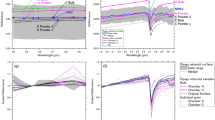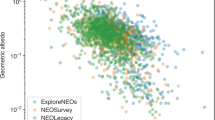Abstract
A comparison of the laboratory reflectance spectra of meteorites with observations of asteroids revealed that the latter are much ‘redder’, with the spectral difference explained by ‘space weathering’1,2, though the actual processes and timescales involved have remained controversial3,4. A recent study5 of young asteroid families concluded that they suffered only minimal space weathering. Here we report additional observations of those families, revealing that space weathering must be a very rapid process—the final colour of a silicate-rich asteroid is acquired shortly after its ‘birth’ (within 106 years of undergoing a catastrophic collision). This rapid timescale favours solar wind implantation as the main mechanism of space weathering, as laboratory experiments have shown that it is the most rapid of several competing processes. We further demonstrate the necessity to take account of composition when evaluating weathering effectiveness, as both laboratory and asteroid data show an apparent dependence of weathering on olivine abundance. The rapid colour change that we find implies that colour trends seen among asteroids are most probably due to compositional or surface-particle-size properties, rather than to different relative ages. Apparently fresh surfaces most frequently seen among small near-Earth asteroids may be the result of tidal shaking that rejuvenates their surfaces during planetary encounters6,7.
This is a preview of subscription content, access via your institution
Access options
Subscribe to this journal
Receive 51 print issues and online access
$199.00 per year
only $3.90 per issue
Buy this article
- Purchase on Springer Link
- Instant access to full article PDF
Prices may be subject to local taxes which are calculated during checkout



Similar content being viewed by others
References
Clark, B. E., Hapke, B., Pieters, C. & Britt, D. in Asteroids III (eds Bottke, W. F., Cellino, A., Paolicchi, P. & Binzel, R. P.) 585–599 (Univ. Arizona Press, 2002)
Chapman, C. R. Space weathering of asteroid surfaces. Annu. Rev. Earth Planet. Sci. 32, 539–567 (2004)
Jedicke, R., Nesvorný, D., Whiteley, R., Ivezić, Ž. & Jurić, M. An age-colour relationship for main-belt S-complex asteroids. Nature 429, 275–277 (2004)
Willman, M. et al. Redetermination of the space weathering rate using spectra of Iannini asteroid family members. Icarus 195, 663–673 (2008)
Mothé-Diniz, T. & Nesvorný, D. Visible spectroscopy of extremely young asteroid families. Astron. Astrophys. 486, L9–L12 (2008)
Nesvorný, D., Jedicke, R., Whiteley, R. J. & Ivezić, Ž. Evidence for asteroid space weathering from the Sloan Digital Sky Survey. Icarus 173, 132–152 (2005)
Marchi, S., Magrin, S., Nesvorný, D., Paolicchi, P. & Lazzarin, M. A spectral slope versus perihelion distance correlation for planet-crossing asteroids. Mon. Not. R. Astron. Soc. 368, 39–42 (2006)
Nesvorný, D. & Vokrouhlický, D. New candidates for recent asteroid breakups. Astron. J. 132, 1950–1958 (2006)
McFadden, L. A., Gaffey, M. J. & McCord, T. B. Near-Earth asteroids — Possible sources from reflectance spectroscopy. Science 229, 160–163 (1985)
Chapman, C. R. S-type asteroids, ordinary chondrites, and space weathering: The evidence from Galileo's fly-bys of Gaspra and Ida. Meteorit. Planet. Sci. 31, 699–725 (1996)
Binzel, R. P., Bus, S. J., Burbine, T. H. & Sunshine, J. M. Spectral properties of near-Earth asteroids: Evidence for sources of ordinary chondrite meteorites. Science 273, 946–948 (1996)
Clark, B. E. et al. Space weathering on Eros: Constraints from albedo and spectral measurements of Psyche crater. Meteorit. Planet. Sci. 36, 1617–1637 (2001)
Hiroi, T. et al. Developing space weathering on the asteroid 25143 Itokawa. Nature 443, 56–58 (2006)
Strazzulla, G. et al. Spectral alteration of the meteorite Epinal (H5) induced by heavy ion irradiation: A simulation of space weathering effects on near-Earth asteroids. Icarus 174, 31–35 (2005)
Hapke, B. Space weathering from Mercury to the asteroid belt. J. Geophys. Res. 106, 10039–10073 (2001)
Sasaki, S., Nakamura, K., Hamabe, Y., Kurahashi, E. & Hiroi, T. Production of iron nanoparticles by laser irradiation in a simulation of lunar-like space weathering. Nature 410, 555–557 (2001)
Bus, S. J. Compositional Structure in the Asteroid Belt: Results of a Spectroscopic Survey. Ph.D. thesis, Massachusetts Inst. Technol. (1999)
Sunshine, J. et al. High-calcium pyroxene as an indicator of igneous differentiation in asteroids and meteorites. Meteorit. Plan. Sci. 39, 1343–1357 (2004)
Vernazza, P. et al. Compositional differences between meteorites and near-Earth asteroids. Nature 454, 858–860 (2008)
Vernazza, P. et al. Physical characterization of the Karin family. Astron. Astrophys. 460, 945–951 (2006)
Pieters, C. M. et al. Space weathering on airless bodies: Resolving a mystery with lunar samples. Meteorit. Planet. Sci. 35, 1101–1107 (2000)
Sasaki, S. et al. Simulation of space weathering by nanosecond pulse laser heating: Dependence on mineral composition, weathering trend of asteroids and discovery of nanophase iron particles. Adv. Space Res. 29, 783–788 (2002)
Marchi, S., Brunetto, R., Magrin, S., Lazzarin, M. & Gandolfi, D. Space weathering of near-Earth and main belt silicate-rich asteroids: Observations and ion irradiation experiments. Astron. Astrophys. 443, 769–775 (2005)
Gaffey, M. J. et al. Mineralogical variations within the S-type asteroid class. Icarus 106, 573–602 (1993)
Binzel, R. P. et al. Observed spectral properties of near-Earth objects: Results for population distribution, source regions, and space weathering processes. Icarus 170, 259–294 (2004)
Shkuratov, Y., Starukhina, L., Hoffmann, H. & Arnold, G. A model of spectral albedo of particulate surfaces: Implications for optical properties of the Moon. Icarus 137, 235–246 (1999)
Brunetto, R. et al. Modeling asteroid surfaces from observations and irradiation experiments: The case of 832 Karin. Icarus 184, 327–337 (2006)
Cruikshank, D. & Hartmann, W. K. The meteorite-asteroid connection: Two olivine-rich asteroids. Science 223, 281–283 (1984)
Starukhina, L. V. Polar regions of the moon as a potential repository of solar-wind-implanted gases. Adv. Space Res. 37, 50–58 (2006)
Bottke, W. F., Vokrouhlikcy, D., Rubincam, D. P. & Broz, M. in Asteroids III (eds Bottke, W. F., Cellino, A., Paolicchi, P. & Binzel, R. P.) 395–408 (Univ. Arizona Press, 2002)
Acknowledgements
The visible data were based on observations at the NTT and VLT (European Southern Observatory, ESO, Chile) and the TNG (La Palma, Canary Islands). The near-infrared data were acquired by the authors operating as Visiting Astronomers at the IRTF, which is operated by the University of Hawaii under Cooperative Agreement no. NNX08AE38A with the National Aeronautics and Space Administration, Science Mission Directorate, Planetary Astronomy Program. This Letter is based on work supported by the National Science Foundation (grant 0506716) and NASA (grant NAG5-12355). Any opinions, findings, and conclusions or recommendations expressed here are those of the authors and do not necessarily reflect the views of the National Science Foundation or NASA.
Author Contributions P.V. performed the quantitative analysis that solidified the results of this paper and led the formulation of possible explanations. P.V., R.P.B. and A.R. served as principal investigators to acquire the visible and near-infrared data. Most data were acquired by P.V., R.P.B and A.R. P.V. and R.P.B. worked jointly to write the paper. All authors discussed the results and commented on the manuscript.
Author information
Authors and Affiliations
Corresponding author
Supplementary information
Supplementary Information
This file contains Supplementary Data, Supplementary Tables 1-3 and Supplementary Figures 1-6 with Legends (PDF 475 kb)
Rights and permissions
About this article
Cite this article
Vernazza, P., Binzel, R., Rossi, A. et al. Solar wind as the origin of rapid reddening of asteroid surfaces. Nature 458, 993–995 (2009). https://doi.org/10.1038/nature07956
Received:
Accepted:
Issue Date:
DOI: https://doi.org/10.1038/nature07956
This article is cited by
-
Impact-driven disproportionation origin of nanophase iron particles in Chang’e-5 lunar soil sample
Nature Astronomy (2022)
-
Evidence for a significant Kuiper belt dust contribution to the zodiacal cloud
Nature Astronomy (2022)
-
Asteroid families: properties, recent advances, and future opportunities
Celestial Mechanics and Dynamical Astronomy (2022)
-
In situ observations of ions and magnetic field around Phobos: the mass spectrum analyzer (MSA) for the Martian Moons eXploration (MMX) mission
Earth, Planets and Space (2021)
-
Surface refreshing of Martian moon Phobos by orbital eccentricity-driven grain motion
Nature Geoscience (2019)
Comments
By submitting a comment you agree to abide by our Terms and Community Guidelines. If you find something abusive or that does not comply with our terms or guidelines please flag it as inappropriate.



